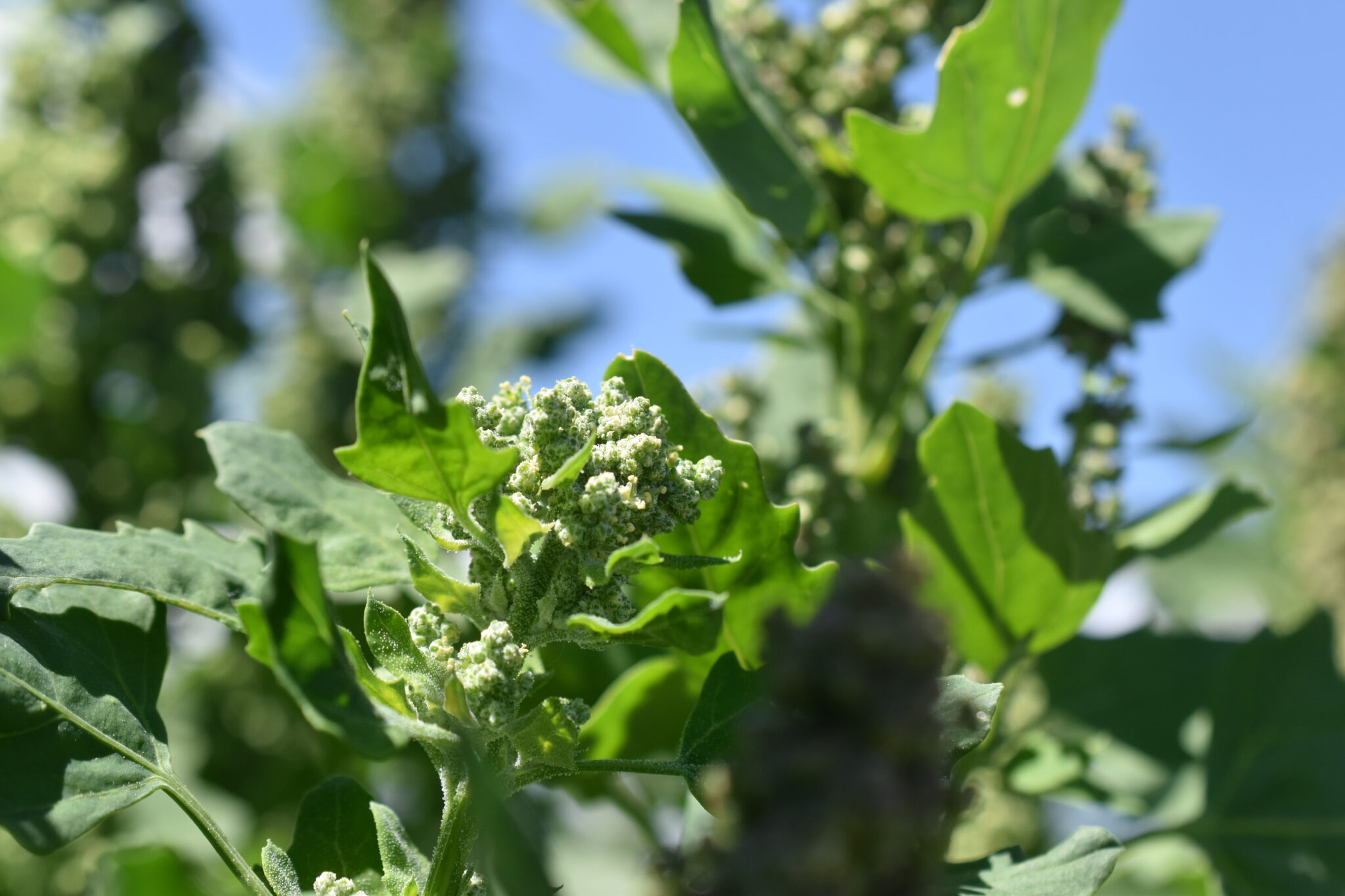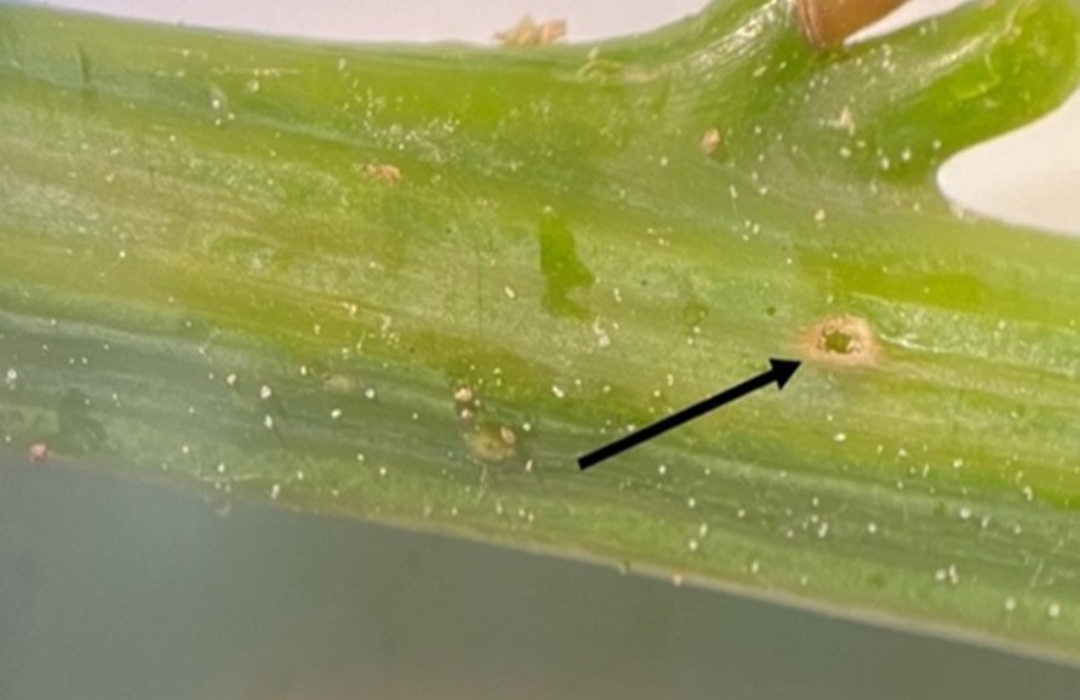
A quinoa field in the San Luis Valley (Photo by Paul New)
A few years ago, Paul New started noticing pin-size holes in some of the stems of the quinoa plants growing on his farm in the San Luis Valley. He didn’t think too much of it at first; there was plenty of other work to keep him busy. Besides, New had been successfully growing quinoa in the valley for decades and hadn’t run into too much trouble.
In 2021, though, New’s quinoa yields took a noticeable hit. He thought back to those tiny holes and started opening some of the stems to investigate further. Upon closer inspection, New discovered a maggot hidden on the inside of the plant, an insect he’d not seen before.
“When you get something specific like this, it catches you off guard a little,” New said. “I’m thinking, ‘Where did this come from? And what are we going to do about it?’”
Around that time, Ada Szczepaniec, an associate professor in horticulture entomology at Colorado State University, was approached by a San Luis Valley crop consultant who had heard about the destructive, stem-boring fly in the valley and wondered if she might be able to help.
Szczepaniec had been studying a separate quinoa-related pest, but decided to pivot her research because this particular problematic fly presented an opportunity to be more immediately helpful to farmers. Although the insect had been reported in Canada, it had not previously been found in the U.S., and little was known about its habits. (Since being discovered in Colorado, the fly has also been found in Idaho, Washington and Oregon, three other quinoa-producing states.)
“I don’t dream up experiments or research topics — I like to work on real problems,” Szczepaniec said. “It’s really important to me to have stakeholder input, listen to people out in the field, and work on applied research problems. This pest in particular had real potential to affect people’s lives.”


Quinoa plants out in the field (Photos by Paige Olson)
A promising crop
The San Luis Valley sits 7,500 feet in the air and stretches flat as a pancake across an area roughly the size of New Jersey. Potatoes are king in this part of south-central Colorado, but quinoa has become a promising crop. The plant grows well in high-desert areas and can thrive without much water, a favorable trait in the drought-stricken West.
Prior to the pandemic, farmers in the San Luis Valley were planting about 3,000 acres of quinoa, an all-time high for the region. This new pest, however, had a significant impact in a short time. In 2022, quinoa acreage plummeted to about 900. This past season, producers dropped the crop from all but a few fields because they had no way to manage the pest.
With the benefit of hindsight, New wonders whether the fly had been impacting his quinoa well before he was aware the insect existed. “I think it’s been an issue much longer than we’ve realized,” he said. “The populations of this fly may have just finally come up enough to where we’re noticing it, but I do think there was some yield loss that we didn’t realize.”
New and others had spent years developing a market for the healthy grain. “It’s so versatile and nutritious,” he said. “But what got us most interested in it was how little water it can survive on — that was a big deal.”
The crop took off around 2018, when another valley farmer, Sheldon Rocky, helped establish a key partnership with Ardent Mills, a Denver-based flour-milling and grain company. South American farmers produce much of the quinoa that is sold in grocery stores, but Ardent Mills helped New and others identify alternate options, supplying quinoa for products such as crackers and granola bars and selling directly to restaurants.
The pandemic, however, temporarily wiped out both markets. Many restaurants shuttered and suddenly there was little interest in pushing new kinds of whole grain crackers. Still, New remained committed to quinoa long term; he figured he’d take the opportunity to focus on optimizing his crop production. Then, he found that maggot burrowed inside tiny holes on the stems of his plants.
“We had no idea what the life cycle is; what the controls are,” New said. “That’s when we got ahold of Ada.”


Exit hole on the quinoa stem caused by the pest (courtesy of Ada Szczepaniec) and a close-up image of the fly (courtesy of Tim McNary)
How to handle
Szczepaniec learned about the fly too late to conduct field research in 2021, but she was prepared for the following year. She set up trapping mechanisms and learned that the fly’s peak activity occurred in late June or early July. She also collected samples from the stems of different varieties of quinoas to examine whether the fly hit one variety more than others.
Based on her initial data collection, Szczepaniec received a U.S. Department of Agriculture grant to study the fly for two years with the aim of developing ways to help farmers handle it. Szczepaniec recently completed year one of the work and will begin to assess different options for how best to control the fly heading into year two. She’s also formed an advisory group of producers in the valley to help her make sure the research is relevant to their needs on the ground.
One approach is to identify other potential host plants that could lure the fly away from quinoa or to find a weed that the fly might feed on instead. Another option is to look for a more fly-resistant variety of quinoa or design a field and crop rotation scheme that could drive out the pest. Pinpointing useful pesticides might also be a possibility.
Finding a way to control the fly is made more challenging because it bores into the stems of the plants, naturally shielding it from, say, an enemy or a chemical. “We’re going to look at all the approaches we have available and see what we can do with a pest this challenging,” Szczepaniec said. “Stem borers are the most difficult to suppress in food crops.”
The changing climate means discovering new pests is something that will likely happen more often, said Eugene Kelly, deputy director of CSU’s Agricultural Experiment Station, which includes a research center in the San Luis Valley. “This is an example of the types of things that agriculturalists are facing worldwide — new biological invasions,” Kelly said. “These pests create an enormous amount of economic distress and new problems on top of things we’re already dealing with like drought and fires.”
Kelly said that researchers are constantly looking for opportunities to diversify agricultural systems by identifying new crops. Given that quinoa has been a promising addition to this part of Colorado, the last thing you want is for a fly to ruin it all, Kelly said. “It’s a crop that has a lot of potential,” he said. “It would be a shame if this was something that stalled the progress we’re making.”
For his part, New plans to meet with Szczepaniec and the advisory group in November and hopes that their discussion will produce at least a few ideas he can try this spring. “We’re going to put our heads together to try to figure something out,” New said. “It takes time.” Still, he added, “the sooner the better.”